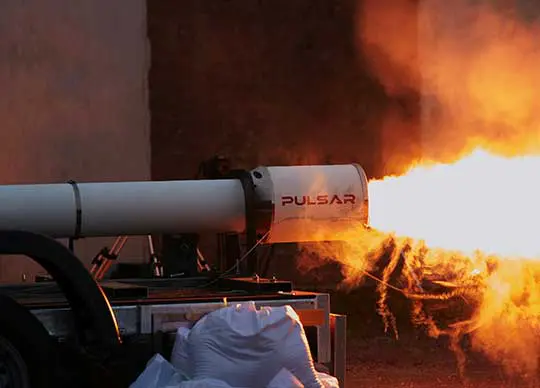
Pulsar Fusion has developed and tested its first launch capable, high-power chemical rocket engine in the UK. The company’s ambition in the future is to produce a hyper-speed propulsion engine using nuclear fusion technologies for interplanetary travel.
This set of test firings showcases the rapid design development and test process of high-performance engineering components to support Pulsar Fusion’s energy and propulsion hardware portfolio roadmap.
This hybrid rocket engine has demonstrated impressive visual plume effects such as supersonic shock diamonds typical of a high temperature, high mass flow rate rocket exhaust.
CEO – Richard Dinan, commented: “We are delighted with the UK test firings at COTEC. It is a hugely significant moment, and we are proud this rocket is built in the UK. To have a British rocket test on UK soil is novel. Pulsar is among a very few companies around the world to have built and tested these technologies. We have a team of fantastic scientists with a wealth of experience to thank for these milestones. We have also drawn talent from some of the UK’s top universities who have begun working with and testing our plasma thrusters at campus facilities. We are extremely proud of these achievements and look forward to expanding our network with the British and European space community with our hardware demonstration later this month in Switzerland.”
Pulsar’s ‘green’ (non-toxic) hybrid rocket engine combusts nitrous oxide (N2O) oxidiser and high-density polyethylene (HDPE) fuel and oxygen. It is a new model that enables Pulsar to manufacture these compact rocket engines at record lead times, with an enhanced safety factor as due to the design, these engines have relatively benign failure modes in comparison with conventional liquid propulsion engines.
A hybrid rocket engine requires control of only one fluid – a liquid oxidiser during testing. Liquid oxidiser is fed under a regulated pressure through a control valve into a combustion chamber containing a technology as proprietary.
Pulsar Fusion received UK government funding in September 2021 to further develop its HET (Hall Effect Thruster) plasma satellite engines, capable of 20 km / second particle exhaust speeds. These Pulsar thrusters have recently been tested at Harwell’s facilities where they withstood 20g’s of vibration, simulating a rocket launch. Pulsar now seeks to IOD test these engines.





